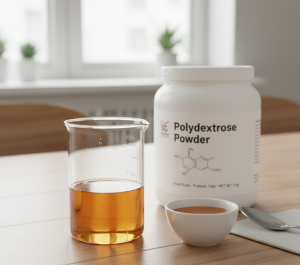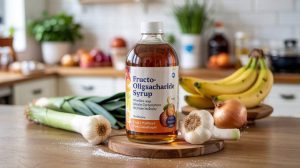Lactitol Monohydrate: A Clean-Tasting Sugar Alternative

We first started using lactitol monohydrate in a batch of sugar-free chocolate truffles. The goal was simple: cut down sugar, keep the texture smooth, and avoid that telltale cooling effect some polyols leave behind. What surprised us? It didn’t just blend in—it delivered. Clean sweetness, excellent moisture balance, and zero blood sugar drama.
That’s the appeal of lactitol monohydrate. It’s not flashy, but it quietly solves some of the trickiest formulation problems, especially in reduced-sugar and diabetic-friendly foods.
What Exactly Is Lactitol Monohydrate?

At its core, lactitol monohydrate is a sugar alcohol derived from lactose—yes, milk sugar—but structurally altered through hydrogenation to form a stable, sweet compound. It looks like a fine white powder, dissolves quickly in water, and holds up under heat. The “monohydrate” part simply means each molecule carries a bit of water, which helps with texture and shelf life in formulations.
Sweetness-wise, it clocks in at about 30–40% of sucrose but with far fewer calories and a low glycemic impact. For food scientists and formulators, it’s a reliable tool for replacing sugar without triggering glucose spikes or compromising mouthfeel.
Where It Shines in Real-World Applications
1. Sugar-Free Sweets with Real Structure
Whether it’s hard candies, caramels, or soft-centered chocolates, lactitol helps preserve texture while keeping the formula sugar-free. It doesn’t crystallize as easily as some other sugar alcohols, so the final product stays smooth.
2. Bakery Items that Retain Moisture
Unlike erythritol, which can dry out a dough, lactitol plays nicely in cookies, cakes, and even pie fillings. Its hygroscopic nature draws and holds moisture, making it useful for both texture and shelf life.
3. Pharmaceutical Laxatives and Tablets
Thanks to its osmotic activity, lactitol is used as a gentle laxative—particularly for occasional constipation. It’s also tablet-compatible, making it a solid filler or excipient in various pharmaceutical formats.
Key Benefits that Set It Apart
- Low Glycemic Index: Ideal for diabetic products and blood sugar-sensitive consumers.
- Tooth-Friendly: Non-cariogenic—doesn’t contribute to cavities.
- Digestive Support: Acts as a mild laxative in higher doses, which can be both a benefit and a consideration.
- Stable Under Heat & Acid: Performs well in baked goods, syrups, and processed foods.
- Neutral Taste: No bitterness, no strange aftertaste—just a mild, clean sweetness.
How Does Lactitol Compare to Other Sweeteners?
| Sweetener | Calories (kcal/g) | Glycemic Index | Digestive Tolerance | Tooth-Friendly |
| Lactitol | ~2 | Low | Moderate (laxative effect) | Yes |
| Erythritol | 0.2 | Very Low | Excellent | Yes |
| Xylitol | 2.4 | Moderate | Moderate | Yes |
| Sorbitol | 2.6 | Low | Lower | Yes |
Lactitol strikes a middle ground. It’s more digestively active than erythritol but less intense than sorbitol or maltitol. Think of it as a dependable workhorse—not too sweet, not too dry, just right for balanced formulations.
Taste and Mouthfeel: Why Lactitol Stands Out
Many product developers mention that lactitol monohydrate closely mimics the mouthfeel and sweetness of regular sugar without any bitter or artificial aftertaste. In chocolates, candies, and baked goods, it preserves the original flavor profile, giving a clean, natural sweetness that consumers appreciate. Compared to some other sweeteners, lactitol leaves a pleasant, clean finish, making it ideal for formulations where taste authenticity is a must.
Quality Control and Consistency Matter
Consistency is key in ingredient sourcing. Reliable suppliers provide detailed Certificates of Analysis (COA) that include purity levels, moisture content, heavy metal limits, and microbial safety tests. Strict control over moisture during production prevents clumping and ensures smooth processing. These quality factors directly influence the final product’s texture and shelf life, so choosing a supplier with strong quality assurance is crucial.
Is It Safe?
Lactitol has been used safely for decades and is approved by both the FDA (GRAS) and EFSA. It’s well-tolerated in moderate amounts, though—as with most sugar alcohols—going overboard can lead to bloating or mild digestive discomfort.
Those with galactosemia should avoid lactitol due to its dairy origin, but otherwise, it’s considered suitable for most populations, including children, when used responsibly.
Special Diet Compatibility

- Diabetic-Friendly: Low GI and minimal insulin response.
- Gluten-Free: Naturally gluten-free; just verify facility certifications.
- Vegan Considerations: While it’s derived from lactose, many suppliers now offer lactose sourced from dairy-free fermentation—check with your supplier for clarity.
- Keto-Compatible: While not zero-carb, it’s usable in small quantities for net carb-conscious formulations.
Practical Tips for Formulators
When using lactitol monohydrate:
- Start with a 1:1 substitution for sugar in bulk but adjust for sweetness.
- Combine with high-intensity sweeteners (e.g., sucralose, stevia) to hit your desired taste target.
- Account for its moisture-attracting nature—adjust baking time or dry mixes accordingly.
- Expect less browning than sugar—caramelization is more muted, so flavor layering matters.
Choosing the Right Supplier Matters
Not all lactitol is equal. Look for:
- ≥ 98% purity with COA verification
- Non-GMO, allergen-free declarations
- Pharma & food-grade production standards
- Moisture-protective packaging (25kg bags, fiber drums, etc.)
- Technical support to guide dosage, performance trials, and regulatory docs
We work with manufacturers and R&D teams across food, pharma, and nutrition to deliver consistently high-quality lactitol. If you’re sourcing for bulk or scale-up, [get in touch here]—our lab team is happy to help optimize your formulation.
Citation:
According to research published in the European Journal of Clinical Nutrition, lactitol does not significantly raise postprandial glucose or insulin levels, making it a viable option for diabetic food formulations (Storey & Lee, 2004).
For safety guidelines, refer to the FDA’s GRAS notice (GRN No. 000077) and EFSA’s scientific opinion on sugar alcohols (EFSA Journal 2010;8(10):1465).
Related recommendations
-
Can vitamin b12 deficiency be a sign of cancer
355Learn whether vitamin B12 deficiency may signal cancer, its common causes, symptoms, and when to seek medical advice.
View details -
In-depth Analysis Of Global Polydextrose Suppliers
328Get an in-depth analysis of global polydextrose suppliers, market trends, certifications, and key sourcing insights.
View details -
Is Maltitol Syrup Gluten Free? A Comprehensive Guide
881Maltitol Syrup Is A Gluten-Free Sweetener Used In Sugar-Free Foods. Learn What It Is And Why Sgnutri Recommends It.
View details -
How Fructo-Oligosaccharide Syrup Supports Gut Health and Nutrition
757Discover How Sgnutri Fructo-Oligosaccharide Syrup Supports Gut Health Through Prebiotic Function And Digestive Balance.
View details
 SGNUTRI
SGNUTRI



